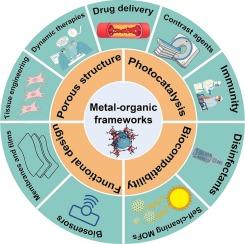Advancing biocompatible metal-organic frameworks in personalized biomedical applications
IF 23.5
1区 化学
Q1 CHEMISTRY, INORGANIC & NUCLEAR
引用次数: 0
Abstract
The widespread of the global epidemic has prompted our human beings to pay unprecedented attention to their own health and safety, and the demand for advanced biomedical treatment options has been continuously increasing. Among many emerging medical materials, metal-organic frameworks (MOFs) stand out due to their high specific surface areas and tunable pore sizes, design versatility, biocompatibility, and the ability to generate reactive oxygen species (ROS). In order to bridge the gap between MOFs materials and modern biomedical applications, this review discusses the applications of MOFs in multiple fields from both in vivo and in vitro perspectives, including in vitro applications such as disinfectants, self-cleaning materials, drug adsorption, antibacterial MOF membranes and films, MOF antimicrobial pharmaceuticals and tissue engineering, and in vivo applications such as MOF dynamic therapy, targeted drug delivery, MOF contrast agents, and MOF vaccines. We hope to prompt and unleash the immense potential of MOFs as an emerging biomedical material and provides valuable insights for the future development of MOFs in modern biomedical and healthcare applications.

推进生物相容性金属-有机框架在个性化生物医学应用中的应用
全球疫情的广泛蔓延,促使人类对自身健康和安全的重视程度前所未有,对先进生物医学治疗方案的需求不断增加。在许多新兴的医疗材料中,金属有机框架(mof)因其高比表面积和可调孔径、设计通用性、生物相容性以及产生活性氧(ROS)的能力而脱颖而出。为了弥合MOF材料与现代生物医学应用之间的差距,本文从体内和体外两方面论述了MOF在体外领域的应用,包括MOF在消毒剂、自洁材料、药物吸附、抗菌MOF膜和膜、MOF抗菌药物和组织工程等方面的体外应用,以及MOF在体内动态治疗、靶向给药、MOF造影剂等方面的应用。以及财政部疫苗。我们希望促进和释放mof作为一种新兴生物医学材料的巨大潜力,并为mof在现代生物医学和医疗保健应用中的未来发展提供有价值的见解。
本文章由计算机程序翻译,如有差异,请以英文原文为准。
求助全文
约1分钟内获得全文
求助全文
来源期刊

Coordination Chemistry Reviews
化学-无机化学与核化学
CiteScore
34.30
自引率
5.30%
发文量
457
审稿时长
54 days
期刊介绍:
Coordination Chemistry Reviews offers rapid publication of review articles on current and significant topics in coordination chemistry, encompassing organometallic, supramolecular, theoretical, and bioinorganic chemistry. It also covers catalysis, materials chemistry, and metal-organic frameworks from a coordination chemistry perspective. Reviews summarize recent developments or discuss specific techniques, welcoming contributions from both established and emerging researchers.
The journal releases special issues on timely subjects, including those featuring contributions from specific regions or conferences. Occasional full-length book articles are also featured. Additionally, special volumes cover annual reviews of main group chemistry, transition metal group chemistry, and organometallic chemistry. These comprehensive reviews are vital resources for those engaged in coordination chemistry, further establishing Coordination Chemistry Reviews as a hub for insightful surveys in inorganic and physical inorganic chemistry.
 求助内容:
求助内容: 应助结果提醒方式:
应助结果提醒方式:


